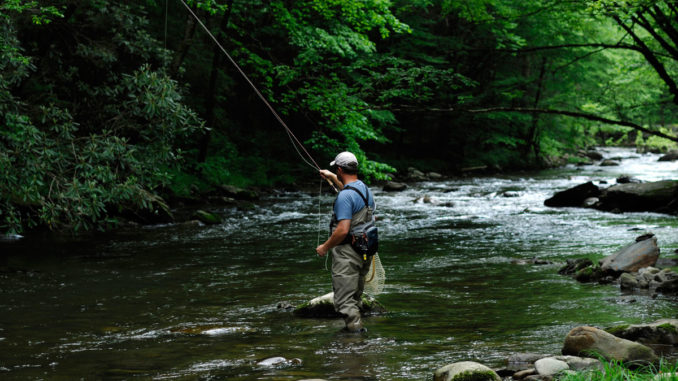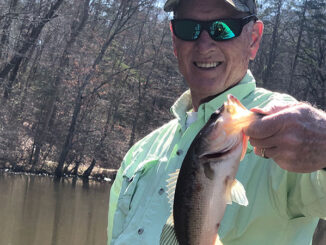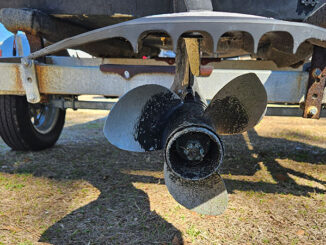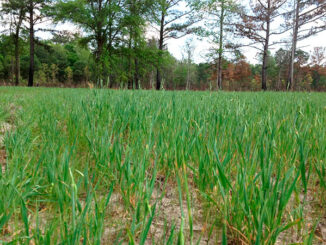
Less fishing pressure, spawning brown trout, better water conditions make November a great month to trout fish on the Davidson County.
When it comes to diversity in mountain trout fishing, North Carolina has it in spades. Think of stalking a tiny tributary stream on the Blue Ridge Parkway for native brook trout versus firing long casts to cover the vast stretches of the Tuckasegee River.
It’s rare, however, that a single river can have multiple, diverse and productive fisheries. One does, however, and it is the storied Davidson River. Fished by locals and visitors alike, many anglers consider the Davidson to be North Carolina’s most- famous trout water, and yet they also see it as the most- frustrating river to fish in the state. Still, they line up, from the spring until late in the fall, hoping to fool one of the wily giants who live there into taking a fly.
The portion of the river known as the Lower Davidson runs from the boundary with the Pisgah National Forest to the confluence of the Davidson with Avery Creek. The N.C. Wildlife Resources Commission has classified this stretch as hatchery supported, meaning that the water is open year-round, excluding March, and allows trout to be harvest by various methods. This is a “put-and-take” fishery in which anglers are allowed to harvest up to seven trout per day, with no size restrictions.
This is a good stretch of the river to take trout home for supper, but it’s not the true test of angling skill that you find upstream. Most of the fish caught will run smaller than those in the rest of the river. As you head upstream, the remainder of the Davidson is designated catch-and-release/artificial flies only.
Mike Hankes of Asheville spends as many days as possible wading the middle portion of the Davidson, fishing by himself or guiding other fishermen. In this section, the trout are immediately more intelligent; Hankes said there are three reasons. First, these fish are subjected to extensive angling pressure just about every day of the year. They are used to seeing waders in the water and flies drifting past. Second, even though some of these fish have been stocked, this portion of the river supports a strong population of spawned fish as well. The instincts of wild fish will eventually take over, even if the parents of those fish were raised in a hatchery. As a rule, wild trout are much more wary than those just released from concrete runs. Finally, many of the fish in the Davidson have been fooled, caught and released before, leaving them even more wise to deal with the efforts anglers put forth.
Hankes owns a multitude of fly rods, but he picks an 8 ½-foot, 5-weight Orvis outfit when he steps into the Davidson. His line of choice is a Scientific Anglers Sharkskin GPX 5-weight, which is looped at the end for leader attachment. He said it is an extremely “workable” setup that will fish well on any trout water but is exceptional for the demands of the Davidson. For his tippet, he will go as light as 5X or even 6X to fool these spooky trout, provided the river is running clear. As far as fly selection goes, Mike is not one to match the hatch. His theory is simple: the Davidson’s trout are used to most anglers throwing exact replicas of the insects they see floating over their heads all day. Instead, he gives them something different to look at. While most anglers spend the late fall tying on blue-wing olives and midges, he’ll fish an attractor dry pattern, like a Wulff or one of his own patterns. It may sound crazy, but more often than not it has been the magic ticket.
When the water is running higher and the color is off, Hankes is prone to fish nymphs. He’ll beef up his tippet slightly, to 4X, and he’ll fish the smallest strike indicator possible. If the indicator twitches or simply stops, he doesn’t hesitate to set the hook. With the amount of rain the Davidson’s watershed receives in the fall, this is a technique he will switch to fairly quickly. Nymphing often results in the biggest catches, especially for brown trout.
Kelly Bandlow, a guide for Davidson River Outfitters, has his excitement level skyrocket when he thinks about fishing the Davidson in October and November. For the past 9 years, he has spent his summers fishing in North Carolina and his winters fishing in the Florida Keys, but he waits to finish the fall season before heading south. Bandlow said that the entire river turns on and fishes well in the fall; the only decision you have to make is what species to target. He will trek as high as Daniel Ridge to chase brook trout, but his favorite fall quarry are the big brown trout that are moving to spawn at this time. Bandlow said these browns will often winter in the French Broad River, so they are definitely on the move with the feed bag on at this time.
Initially, Bandlow likes to fish the Davidson in the fall when the leaves are falling and there is simply more “stuff” in the water. For fishermen, the leaves are a welcome substitute for the dreaded “inner tube hatch” that occurs during the summer and early fall. The leaves — and lack of tubing tourists — put the trout on the feed and make the river much more fishable.
After a summer and early fall of crystal clear, shallow water, with virtually nothing floating in it other than humans, fall conditions on the river may make the trout feel more secure. Whatever the case may be, these are clear indicators to Bandlow that it’s time to get in the river.
He also said the river will fish better when there is some kind of tint to the water. Seasonal rain is a huge asset for anglers, giving the water some tint and making the trout slightly less wary of who is stalking them. Still, he stresses that presentation is the most-important part of hooking Davidson River trout. Getting a perfect, drag-free drift out of your fly will pay the biggest dividends. Even when the water conditions become more forgiving, these trout will pick up on the tiniest amount of drag. Cast accurately, mend often, and ensure that the fly makes the correct drift.
Bandlow said fishermen who are new to the Davidson have to revise their standards for success before taking their first step into the river. To him, if you catch a fish at all, you have had a good day, as there are more than a few anglers who don’t get the chance to set the first hook. Even though many of these trout began life at the nearby hatchery, they aren’t your typical stockers. On the other hand, if you take the time and put in the work, you can enjoy some success.
When renowned artist Hanes Hoffman of Hendersonville isn’t crafting intricate replicas of fish out of copper, he’s often chasing live ones. Hoffman loves to fish not only the Upper Davidson — referring to the area adjacent to the state fish hatchery and upstream towards the headwaters — but the tributary streams. As he moves upriver, he ultimately ends up fishing smaller and smaller water. To deal with the different conditions, he has an entirely different technique to target not only the adapted rainbows, but native brook trout as well.
The Japanese have been fishing tenkara rods for centuries, but this gear was nearly unheard of in the United States until a few years ago. A tenkara system is perhaps the most-simplistic approach to fishing, consisting of a rod 12 feet or longer, a line of equal length to the rod, a leader, tippet and a fly, traditionally a reverse hackle. While the rods were originally made of bamboo, Hoffman opts for the more-contemporary fiberglass, telescopic rods being built. Modern tenkara rods also have removable tips, just in case the angler happens to snap one during a trip. The concept is to scale way back on gear, making the angler more focused on finding the trout and presenting the perfect single fly, regardless of what the pattern may be.
Hoffman said his outings on the river often resemble hunting as much as they do fishing. On a pretty, late-fall day, areas with easy access will almost certainly see heavy traffic, so having less gear allows him to easily work upstream and get away from the crowd. Branching off from the river into a tributary accomplishes the same goal and ultimately allows him to fish cleaner, clearer water as well, especially if the Davidson is running extra high.
Hoffman said he “stalks” the water rather than just wading and fishing. His gear allows for a multitude of presentations to fish that he sees well before starting a cast. The longer rod allows for accurate “bow-and-arrow” casts, perfect for targeting a brook trout holding behind a rock or in a plunge pool. Many times, this cast will be with both feet completely out of the water, even hiding behind a streamside tree.
The same rules that Hankes and Bandlow describe about the perfect drift and presentation most certainly apply. Show the trout a fly that’s floating naturally, right in the feeding lane, and hang on. Hoffman says that the first fish he hooked on his tenkara rod was unexpected, not because he didn’t see the fish, but because it didn’t seem logical that fish could be caught that way. A larger-than-expected rainbow nearly ripped the rod from his hands. Many fish later, the Davidson River trout that he targets still don’t have any apprehension about eating the perfectly presented fly.
DESTINATION INFORMATION
WHEN TO GO/HOW TO GET THERE — Most of the Davidson River can be fished year-round, but visiting fishermen will have their best success in the fall, when the notoriously tough river is at its most forgiving. Cooler, higher water and brown trout moving to spawn are a big reason. The Davidson is most-easily accessed from the town of Pisgah Forest on US 276. From I-26, exit in Hendersonville on US 64 and head west, turning right at the intersection with US 276.
TACKLE/TECHNIQUES — The Lower Davidson River is a hatchery supported stream where live baits and lures of all kinds are allowed 11 months a year. Upstream, waters are wild-trout/artificial flies only. An 8 1/2-foot, 5-weight fly rod will get the job done. Use attractor-style dry flies or nymphs, depending on the water condition. When fishing dries, make sure you get a drag-free drift. Dabbing flies into tight spots with an extra-long, tenkara style rod is a great alternative.
FISHING INFO/GUIDES — Davidson River Outfitters, Pisgah Forest, 888-861-0111, www.davidsonflyfishing.com; Mike Hankes, mlhankes@gmail.com. See also Guides and Charters in Classifieds.
ACCOMMODATIONS — Hampton Inn, Brevard, 828-833-4800; Davidson River Campground (tent and R/V sites), Pisgah Forest, 828-862-5960.
MAPS — Delorme’s N.C. Atlas and Gazetteer, 800-561-5105, www.delorme.com; Pisgah National Forest, U.S. Forest Service, 800-660-0671, www.fs.usda.gov/main/nfsnc/maps-pubs.







